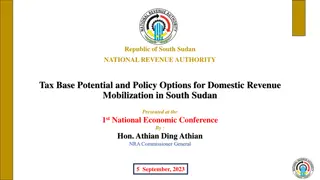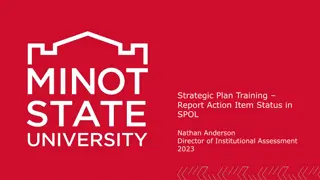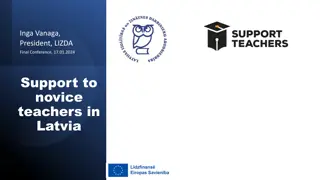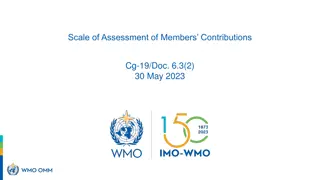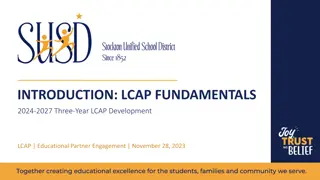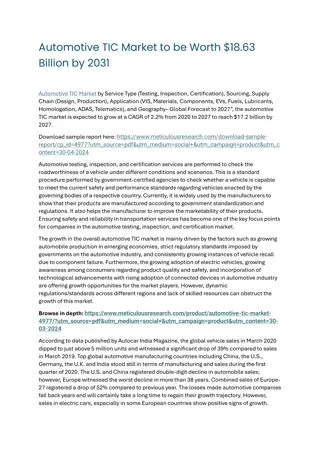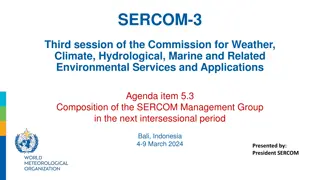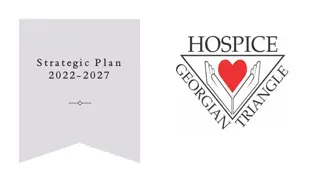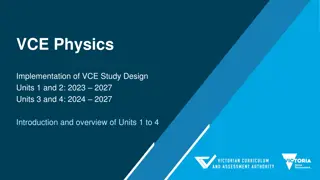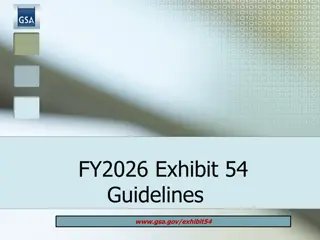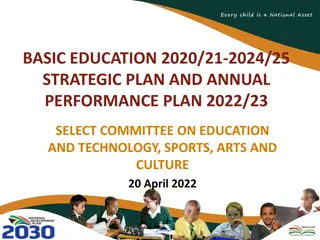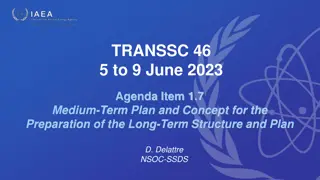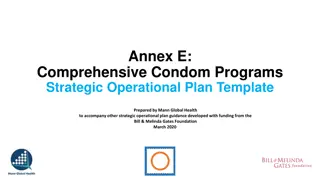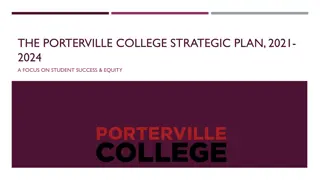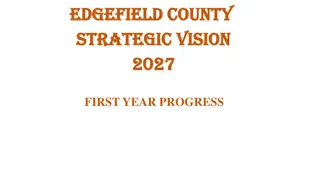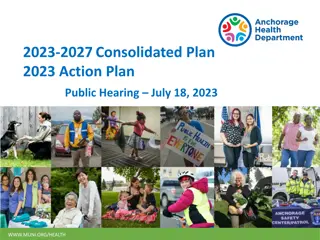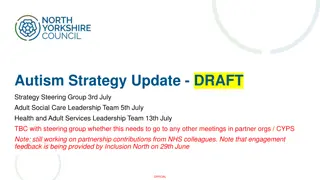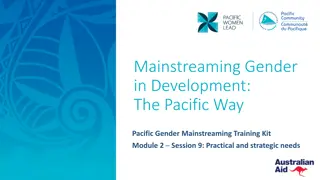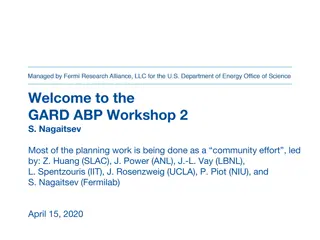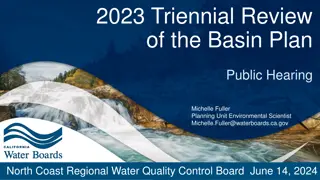Strategic Plan 2024-2027: Better Serve Societal Needs
Delivering authoritative, user-oriented information and services to strengthen national early warning systems, enhance climate information provision, and support climate-related policy implementation.
Download Presentation

Please find below an Image/Link to download the presentation.
The content on the website is provided AS IS for your information and personal use only. It may not be sold, licensed, or shared on other websites without obtaining consent from the author.If you encounter any issues during the download, it is possible that the publisher has removed the file from their server.
You are allowed to download the files provided on this website for personal or commercial use, subject to the condition that they are used lawfully. All files are the property of their respective owners.
The content on the website is provided AS IS for your information and personal use only. It may not be sold, licensed, or shared on other websites without obtaining consent from the author.
E N D
Presentation Transcript
Hello Bonjour Draft Strategic Plan 2024-2027: Long-Term Goal 1: Better serve societal needs: delivering authoritative, accessible, user-oriented and fit-for-purpose information and services SERCOM-2/Doc. 6 Geneva 17-21 October 2022
LONG-TERM GOAL 1. BETTER SERVE SOCIETAL NEEDS: delivering authoritative, accessible, user-oriented and fit-for-purpose information and services Impact STRATEGIC OBJECTIVE 1.1: Strengthen national multi-hazard early warning/alert systems and extend reach to better enable an effective response to the associated risks Outcome FOCUS AREA/OUTCOME A: FOCUS AREA/OUTCOME C: FOCUS AREA/OUTCOME B: Enhanced access to official national environment-related forecasts and warnings globally in support of regional and global requirements across all time scales Better preparedness, response to and recovery from environment-related hazardous events Intermediary outcomes Enhanced impact- and risk-based extended forecast and warning products and services Global/regional uptake Policy & institutional development Technical development DRR-related standards developed, including for QMS and personnel competencies for EWS WMO Cataloguing of Hazardous Events connected to loss and damage reporting systems * Members capacities enhanced through guidance, training and product development on: Cataloguing high-impact events impact-based forecasting and warning services on multiple timescales (up to extended timescales) for all vulnerable areas, including polar and high- mountain regions Development of probabilistic forecasts using data from global producing centres Technical support on main hazards CAP integrated in technical regulations Atlas on mortality updated and input to the United Nations Framework Convention on Climate Change (UNFCCC) reporting GMAS fully operational Outputs Communities of Practices built WMO-United Nations Office for Disaster Risk Reduction (UNDRR) centre of excellence delivers according to workplan Country risk profiles maintained WCM implemented Business Continuity Plan on responses to crises and sustained operations of the Multi- hazard Early Warning Systems (MHEW) services Members warnings available, aggregated and visualized through the Severe Weather Information Centre (SWIC) and other existing platforms and warning mechanisms leveraged by the GMAS framework WMO register of alerting authorities maintained/updated Strengthened country user interface platforms Regulations on warnings authority developed * Legislation & socio-econ omic benefit analysis Capacity Development Water Ambitions Early Warning Early Action Climate adaptation & GHG Monitoring Legend:
LONG-TERM GOAL 1. BETTER SERVE SOCIETAL NEEDS: delivering, authoritative, accessible, user-oriented and fit-for-purpose information and services Impact STRATEGIC OBJECTIVE 1.2: Broaden the provision of policy- and decision-supporting climate information and services Outcome FOCUS AREA/OUTCOME A: FOCUS AREA/OUTCOME C: FOCUS AREA/OUTCOME B: Improved Members production and delivery of authoritative national climate information products and services in GFCS priority areas in support of climate adaptation WMO climate adaptation and mitigation actions support adopted as official science basis for international climate-related policy implementation and UN system action Member climate services integrated into an enhanced weather, water, climate, and environmental service information system Intermediary outcomes Global/regional uptake Policy & institutional development Technical development * Adaptation and mitigation support services for UNFCCC (stocktake), climate finance mechanisms, development partners and Members Global State of the Climate Reports Regional State of Climate Reports with increasingly comprehensive socioeconomic impacts component State of Climate Services Reports Global Seasonal and Annual to Decadal Climate Updates El Ni o/La Ni a Southern Oscillation (ENSO) Bulletins based on information from designated ENSO lead centres Enhanced visibility, effectiveness and implementation of GFCS to address Members Nationally Determined Contributions (NDC) priorities (agriculture and food security, water, energy, health, DRR and others), with increased access to climate finance Implementation of Climate Science Information for Climate Action to support Members development of adaptation and mitigation plans and policies Member access to climate projections based on the Coupled Model Intercomparison Project (CMIP) and CORDEX scenarios for investments, policies and plans Member participation in NAPs, NDCs, national policies and projects Expanded National Frameworks for Climate Services (NFCS) (including weather and water) Increased Member certification of QMS on climate services Increased access to technical expertise for policies/projects CSIS operationalized on regional and subregional scales through Regional Climate Outlook Forums (RCOFs) and enhanced technical regulations Outputs Members enabled to access, contribute and add value to global and regional climate information and forecast products for service provision * User-based requirements for Regional Climate Centre (RCC) products * * * * Open CDMS and HQ-GDMFC applications rollout Improved processing, exchange and enhancement of decision support info on past, present and future climate * Legislation & socio-econ omic benefit analysis Capacity Development Water Ambitions Early Warning Early Action Climate adaptation & GHG Monitoring Legend:
LONG-TERM GOAL 1. BETTER SERVE SOCIETAL NEEDS: delivering, authoritative, accessible, user-oriented and fit-for-purpose information and services Impact STRATEGIC OBJECTIVE 1.3: Deliver hydrological services for sustainable water management and adaptation Outcome * FOCUS AREA/OUTCOME A: FOCUS AREA/OUTCOME C: FOCUS AREA/OUTCOME B: Strengthened cooperation through interoperable service delivery, policy development and institutional advancements Free and unrestricted exchange of information, products and reports facilitated Members are enabled to provide enhanced hydrological services for water resources management Intermediary outcomes Enabling environment Regional/national implementation Technical development Development of water quality services Global Hydrological Status and Outlook System Work plans of hydrological regional bodies completed and new ones established Projects on water quality under implementation Water Resources Assessment CoP launched and operational Twinning projects between Members targeting Water Resources Management Relevant elements of Water and Climate Coalition Action Plan implemented Tools for interpretation of HydroSOS results for food security for implementation of regional HydroSOS High-level forums at each RA session to support Members to better describe the socioeconomic benefits of NMHSs Outputs Guidelines on development of practical methods for assessment of hydrological information Enhanced customer orientation/marketing tailored products * * Manual on Field Safety Catalogue of relevant information and products generated by WMO at the global and regional scale Generic production processes, metrics and internal guidelines for hydrological information New or improved standards for QMS and personnel competencies for hydrological services * Legislation & socio-econ omic benefit analysis Capacity Development Water Ambitions Early Warning Early Action Climate adaptation & GHG Monitoring Legend:
LONG-TERM GOAL 1. BETTER SERVE SOCIETAL NEEDS: delivering, authoritative, accessible, user-oriented and fit-for-purpose information and services Impact STRATEGIC OBJECTIVE 1.4: Enhance the value of and innovate in the provision of decision-supporting weather information and services Outcome FOCUS AREA/OUTCOME A: FOCUS AREA/OUTCOME C: FOCUS AREA/OUTCOME B: Enhanced user-specific weather services building on international standards and good practices Intermediary outcomes Enhanced weather services and information through increased user engagement Sustained benefits building on policy and funding mechanisms Technical development Regional/national uptake Policy & institutional development Reformed WMO Technical Regulations framework on the delivery of services including alignment to international conventions * Process and metrics on service provision, good practices on provision of tailored services Guidance for Members on engagement processes at national level Consultation with users to understand their needs, especially in the context of a changing climate A monitoring process identified to develop metrics associated with service provision Supporting Members to strengthen their ability/capacity to deliver services * Periodic review and monitoring of new Strategy on Service Delivery New or improved guidance on national and multinational funding models * A methodology/tool for monitoring compliance with WMO Technical Regulations Sectoral tools, techniques and training associated with impact-based forecasting Outputs WMO cascading support framework expanded to fill existing gaps Agreements and working relationships with partners reviewed, improved or established A template for sectoral QMS * New or improved guides and other materials related to services * * New or improved standards for QMS and personnel competencies for aviation and marine services * Legislation & socio-econ omic benefit analysis Capacity Development Water Ambitions Early Warning Early Action Climate adaptation & GHG Monitoring Legend:
LONG-TERM GOAL 1. BETTER SERVE SOCIETAL NEEDS: delivering, authoritative, accessible, user-oriented and fit-for-purpose information and services Impact STRATEGIC OBJECTIVE 1.5: Accelerate the development of integrated systems and services to address global risks associated with irreversible changes in the cryosphere and downstream impacts on water resources and sea level rise Outcome FOCUS AREA/OUTCOME A: FOCUS AREA/OUTCOME C: FOCUS AREA/OUTCOME B: Emerging risks are identified and cross- cutting actions across the value cycle are charted Strategic & institutional development Partnerships and collaborations with external stakeholders amplify existing capacity to deliver services Collaborative mechanisms are optimized to promote innovation, and research to service actions Intermediary outcomes Global/regional enabling environment Technical development Define and operationalize regional mountain and polar monitoring centres; Advance the WMO strategic framework for addressing emerging P&HM risks and their downstream impacts, especially on low-lying regions such as SIDS, to be enabled by an integrated systems approach to service development across globally impacted regions; * Engage with relevant global, regional and national stakeholders, guided by the principles of the value cycle, to ensure societal benefits are achieved through effective translation from research to operations to service delivery systems; Identify cryospheric and environmental P&HM hazards, their associated processes and impacts on people, economies and ecosystems, and integrate in the services framework; Outputs Strengthen long-term programmes for Earth system monitoring, including cryosphere and other relevant environmental influences, to enable continuity of benefits to society in or affected by vulnerable regions; * Develop a high-level statement of ambitions to promote and focus global actions in polar and high-mountain regions; Establish and support a set of indicators of change for the regular monitoring of the state of the cryosphere in support of hydroclimate services at regional levels and global climate monitoring. Document and facilitate linkages across existing programmes and initiatives, reflecting the full value cycle, to support WMO-wide action planning. Advocacy for action in addressing issues in vulnerable regions is informed by sound science and influences international policy frameworks. * Legislation & socio-econ omic benefit analysis Capacity Development Water Ambitions Early Warning Early Action Climate adaptation & GHG Monitoring Legend:


